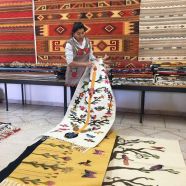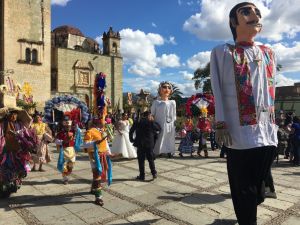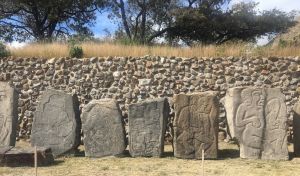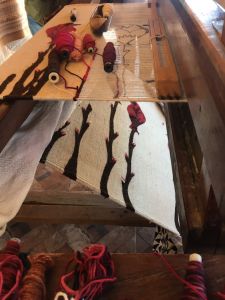Oaxaca’s Future, Not Set in Stone
D. H. Lawrence predicted the future of Oaxaca de Juárez a century ago. Walking the city on the Saturday before Christmas 1924, he captured a certain “reeling, roundward motion” that emanated from the treetops, through the heart of the city and beyond. It was market day.
Everything seems slowly to circle and hover towards a central point, the clouds, the mountains round the valley, the dust that rises, the big, beautiful white-barred hawks, gabilanes, and even the snow-white flakes of flowers upon the dim paloblanco tree. Even the organ cactus, rising in stock-straight clumps, and the candelabrum cactus, seem to be slowly wheeling and pivoting upon a centre, close upon it.
This circular movement culminated in the bustling market itself, where Zapotecs, Mixtecs, and Spanish had come
to buy and to sell, but above all, to commingle. In the old world, men make themselves two great excuses for coming together to a centre, and commingling freely in a mixed, unsuspicious host. Market and religion. These alone bring men, unarmed, together since time began. A little load of firewood, a woven blanket, a few eggs and tomatoes are excuse enough for men, women, and children to cross the foot-weary miles of valley and mountain. To buy, to sell, to barter, to exchange. To exchange, above all things, human contact.
Unwittingly, Lawrence was describing Oaxaca as my family and I experienced it this past Christmas season. Religion melding into market: wedding parties processing from church to plaza where vendors ply their trade undisturbed, offering smoothly carved wooden kitchenware, handwoven fabrics of intricate design, icons of the Virgin in multiple guises, all variety of antojitos (little cravings, hot off the food cart). While today’s vendors bring their goods in on trucks rather than beasts of burden, while English contributes increasingly to the cacophony of languages, while Visa cards are accepted as commonly as pesos, the essential acts of buying and selling, of exchanging human contact, still animate the street markets of downtown Oaxaca.
The markets continue into the cool December evenings, enhancing the general festivity of the season. Seven-pointed pinatas—seven deadly sins to be slain—dangle above the streets from strands of light. Potted plants of native poinsettias (a rangy shrub in the wild) punctuate a streetscape already bright with bougainvillea, trumpet flowers, birds-of-paradise. On several nights, we chanced upon posadas making their way down the sidewalks (if on foot) or streets (if mounted on a truck). A posada reenacts Mary and Joseph’s search for an inn (a posada). They take place on each of the nine evenings before Christmas—representing Mary’s nine months of pregnancy—with the most elaborate reserved for the festivities of Christmas Eve.
The posada is of Spanish colonial origin. Like so many manifestations of Latin American Catholicism, it represents a strategic appropriation of an older tradition. Tasked with converting peoples whose languages they did not understand, sixteenth-century Dominican evangelists resorted to art, music, and ritual theater. The nativity story was superimposed upon the Aztec celebration of the arrival of Huitzilopochtli, god of war, which took place around the winter solstice.
So a native celebration returns, reinvented by the colonizers, interpreted anew by young Oaxacans each year. Lawrence’s reflections on Oaxaca as site of circular movement remain apt, encompassing more than the centripetal pull of the market. In spite of the neat modern street grid helpfully laid down by the Spanish, the entire city of Oaxaca is a space where signs of its multilayered past ring through to the present at every turn.
Oaxaca de Juárez sits mile-high in a desert valley, a tropical savannah, sprawling into the foothills of the Sierra Madre Oriental and Sierra Madre del Sur. Hundreds, if not thousands, of ancient ruins surrounding the city (most still unexcavated) reinforce a deep sense of time. The most impressive of these is the complex the Spanish named Monte Albán. One of the earliest cities in Mesoamerica, Monte Albán commanded a sprawling and constantly contested Zapotec empire for close to a thousand years.
The structures at Monte Albán date from around 500 bce. Pictographic images represent one of the earliest writing systems in Mesoamerica, although the key to their interpretation is lost. Even more puzzling are the curious human shapes carved on stone slabs, in what early archaeologists thought were the poses of dancers, or swimmers, but are now presumed to convey something more sinister. The going theory is that they depict war prisoners: there’s nothing like a series of castrated men in distressed, impossible poses to communicate the intentions of an emerging state gathering its power.
At its peak, around 300–700 ce, Monte Albán was a domineering urban center with a population of around 30,000, a highly organized society wielding spiritual, political, and economic control of a network of perhaps 200 settlements. But over the course of two or three centuries, Monte Albán’s future vanished: the site was gradually abandoned, for reasons not entirely clear.
Hearkening much further back, caves and rock shelters east of the city of Oaxaca bear witness to the presence of nomadic hunter-gatherers ten millennia ago. The wall art in these inhospitable spaces signifies human occupation at once hard to deny and impossible to fathom. Here, archaeologists have teased out some of the evidence of the transition from hunting to farming: seed varieties found in one cave come from some of the earliest known domesticated plants in North America. The earliest evidence of cultivated corn was found here.
Living in the shadow of lost civilizations in a harsh desert environment could lead to long thoughts on “the isolated tininess of human effort,” as Lawrence puts it in observing the vastness of rural Oaxaca. Or maybe that’s the gringo’s impression. It’s worth noting, for example, that though Monte Albán collapsed, Zapotec culture did not. After its fall, the Zapotecs dispersed into numerous small centers across southern Oaxaca, where they thrived for centuries, bound by common religious traditions.
It’s an irony of history that what we know of Zapotec religion comes from sixteenth- and seventeenth-century Spanish priests whose job it was to stamp out native heresies. They were not entirely successful, of course. Anthropologist Michael Lind tells us that while the Spanish extracted confessions from Zapotec priests, the same priests arranged for the local deities to continue to be worshiped in secret. Moreover, in time the Zapotecs simply reinvisioned the Catholic icons as their own. The church became, as Lind puts it, “the ‘new’ Prehispanic temple” in which the Zapotecs chose to find novel variations on familiar deities. The Virgin of Guadalupe, a felt presence throughout Mexico to this day, is the greatest example of the syncretism that was reshaping indigenous religions as the Spanish waged their campaigns of spiritual conquest. Uniquely Mexican-Catholic, she is a dark-skinned Mary blended with a popular Aztec earth-mother goddess: this virgin is divine in her own right.
In The Meeting of East and West—a once-influential book describing the major world cultures at the end of World War II—philosopher F. S. C. Northrop admires the “aesthetic intuition” that informs Mexican self-expression. “The native Mexican appreciation of color and form for its own sake made of the Catholic churches of Mexico something unique in the history of art,” he writes. Spanish Colonial style is “not merely a copy of imported European forms but an original and spontaneous creation” of the indigenous spirit. Nor is this fusion of native art and spirituality with the fervor of Catholic ritual expression “merely a thing of the past,” he continues. “Clearly, here is something which has captured the emotions and souls of the people.”
Like D. H. Lawrence before him, Northrop in the 1940s may as well have been describing Oaxaca (city and state) in the early twenty-first century. Lushly rendered art and design saturate the built environment. The legacy of a rich spiritual heritage springs forth in exuberant festivals marking major holidays, as we experienced in the city on Christmas Eve. Especially after dark, with the floats and the music and the fantastical oversize papier-mâché puppets dancing about, Oaxaca resembles a haven out of time: not frozen in time, but a place where change happens slowly, informed by the wisdom of the ancestors.
But Oaxaca is not sheltered from the winds of late capitalism. Eighteen years ago, for example, McDonald’s wanted to open a restaurant in the city’s historic sixteenth-century zócalo. The activism of thousands—led by artist/activist Francisco Toledo, who threatened to stand naked at the site but instead gave out free tamales—drove McDonald’s away. At the same time, more practical-minded Oaxacans wondered if it wouldn’t be smart to welcome the investment.
Oaxaca ranks consistently as one of the poorest states in Mexico, running neck and neck with neighboring Chiapas and Guerrero. These are the southernmost reaches of Mexico, where indigenous populations predominate. The Mexican government has compounded the Spanish practice of exploiting the colonized here, the impacts deeply felt. According to recent statistics, 70.4 percent of Oaxaca’s population lives below the poverty line, with 26 percent in extreme poverty. Speaking in 2016 in Chiapas, where a quarter-century ago the Zapatistas launched an insurrectionist struggle for democracy and land reform that still reverberates, Pope Francis condemned the government’s conscious, systematic neglect of its indigenous citizens.
Against such need, large-scale investment as a bridge to economic improvement offers some appeal. But at what risk to local culture and identity? As multinational capitalism continues its relentless expansion, this is the critical question for this vital pocket of the Global South.
* * *
Fernando Méndez is a bright young Oaxacan whose elfin eyes smile beneath a palm-leaf sombrero as he introduces himself to us in the foyer of Las Golondrinas, our villa hotel. Our tour guide for five memorable days in the city as well as in the silent ruins and lively towns of rural Oaxaca, he approaches his work with the mind of an anthropologist and the heart of a native son. When he imagines thirty to fifty years out, he worries. Economic progress is essential, he agrees, but what does progress look like? Can the standard of living of Oaxaca’s poor and indigenous people be raised without the erasure of cherished traditions, without the erosion of local autonomy?
He worries about President Andrés Manuel López Obrador’s plan to turn the Isthmus of Tehuantepec into a cargo rail corridor competitive with the Panama Canal. The isthmus spans the continent from the Pacific Ocean to the Gulf of Mexico, through Oaxaca and Veracruz. Transforming it into a strategic trade route, the dream of Cortez, became reality of a sort in the late nineteenth century with a rail line built by Porfirio Díaz’s government. But the Panama Canal’s opening in 1914 discouraged its upkeep.
The Trans-Isthmus Interoceanic Multimodal Corridor project would bring the old dream to life. Over $1 billion in federal pesos has already been committed, a fraction of the total cost. Among the improvements to accompany a modernized railroad and expanded cargo handling capacity are a widened highway and a fiber optic telecommunications network; specialized economic zones alongside the route would target private investment. The new zones would facilitate the manufacture of local goods for shipment to distant markets, boosting incomes in this impoverished region. Whether these developments would enhance the local quality of life is not so certain, though, and this is the question that worries Méndez.
Most communities in the Tehuantepec region of Oaxaca are indigenous villages practicing self-government through the communal system known as Usos y Costumbres (uses and customs). This prehispanic practice gained legal status in 1995 during the debates provoked by the Zapatista rebellion. Officeholders are selected in caucus-style open meetings. People assume progressively responsible positions: the mayor may have been a project manager, town council member, and/or director of the community museum. Even land is owned communally. “Uses and customs” strengthens the community’s sense of cohesion and agency, Méndez believes; it increases civic participation and boosts ethnic pride. At its best, this cooperative practice merges successfully with capitalism to produce healthy and distinctive local economies.
The village of Teotitlán del Valle well illustrates such success, Méndez points out. After a Dominican bishop introduced sheep and the treadle loom to this community already known for its weaving, the village gained an enduring reputation for high-quality textiles. Today it enjoys a healthy tourist economy centered on textile production.
Managing the markets is a community responsibility in Teotitlán del Valle. So is public health. Some people might paint notices on the sides of buildings—reminders of a woman’s right to choose, or that vaccinations are important, or that sexual violence is not okay. If you’re a boy, you might join the team ringing the church bells (three days straight!) during Día de los Muertos. A dozen young male dancers satisfy their community obligations—and keep an important tradition alive—by performing the Danza de la Pluma (Dance of the Feathers), an ancient Aztec dance featured in festivals and celebrations.
“Uses and customs” is not perfect, Méndez concedes. Not all towns have made it work to their benefit. The community loses when college-educated sons and daughters choose not to return to a place where they’ll have to do work that is largely uncompensated. Women are still excluded in some towns. The system is vulnerable to corruption, like all Mexican politics. But “traditions can change,” he noted, citing Eric Hobsbawm’s The Invention of Tradition. On balance, Méndez believes that “things have a better chance of going right” for the region’s native communities under this locally responsive and accountable form of government than under any other.
In theory, the Trans-Isthmus project offers a way to collaborate with local communities. Again thanks to pressure from the Zapatistas, the Mexican government is bound by Convention 169 of the International Labor Organization, an agreement that grants indigenous communities the right of “consultation and participation” in decision-making processes affecting them. Accordingly, the government has held public hearings. But Méndez questions the good faith behind these meetings. A representative of the National Indigenous Congress called them “a lie, a simulation, a trick”: consultation as cooptation.
Reasonable fears driving the opposition to this massive capital project include the erosion of native traditions and languages, the loosening of community ties, rising inequities, and the destruction of valuable ecosystems. Such worries find resonance in the American South, where the proposed Atlantic Coast Pipeline threatens similar harm to poor and historically marginalized African American and indigenous communities, and to critical ecosystems, across a 600-mile route from the Appalachian mountains to the Lumbee River. The pipeline project offers no direct community benefits: its function is simply transport, carrying fracked natural gas to existing domestic power plants. With no guaranteed right even to consultation, these communities have turned to the courts to press claims of discrimination and abuse of process under state and federal law. Despite their multiple impressive victories, this story is not finished.
As the Trans-Isthmus project is built out and job opportunities arise in nearby towns and villages, Méndez predicts, it will attract workers with a “completely different worldview” from that of the native people: “highly individualistic, private lives” versus “allegiance to the commons and public life.” Educated Mexicans with twenty first-century skills will do well, he continued. “This project will be huge for putting Mexico back in geopolitics.” It might bring opportunities for those who have already migrated from the isthmus to return to a more prosperous region. It could even inspire the next generation’s Francisco Toledo, a native of the isthmus. But “unless they make superhuman efforts to invest in educating people, it doesn’t seem likely that there will be local integration.”
Méndez worries about another impact of the global economy on Oaxaca as well: the exploitation by international producer-distributors of the state’s centuries-old tradition of mezcal production. Oaxaca is the world’s leading producer of mezcal. For Oaxacans, mezcal is a potent spiritual elixir that lies at the center of everyday life. Produced in small batches, it is made often by families following methods handed down through the generations. It brightens weddings, births, all celebrations; it tempers any loss or disappointment. (“For everything bad, mezcal, and for everything good, the same.”) It is sold in the city markets and, as we happily discovered, from local producers in upscale tasting rooms. And now a rapid growth of worldwide demand threatens to transform an artisanal drink with the complexity and variety of wine into a mass-produced, standardized product.
Mezcal is “all about diversity,” says Méndez. Its layered, distinctive flavors ride upon a host of factors, including the type of agave used and the characteristics of what the French call terroir: the soil, its elevation, climate, and ecosystem. What individual palenques (small farm distilleries) do with these variables is an art form, the antithesis of industrial production. When mezcal is made in the traditional way, prudent use is made of available sources of agave (often wild varieties), firewood for firing the earthen ovens, and water for use in the fermentation. Agave plants, of which hundreds of species are known to exist, can take decades to mature. Nothing about mezcal production is rushed.
Industrial producers are rushing to market, selecting from a narrow range of agave varieties and harvesting too much too quickly. All three of the main ingredients—agave, firewood, water—are imperiled by increased production. One of Méndez’s stories demonstrates the consequent dangers to Oaxaca’s fragile ecosystem.
Like our century plant (which is an agave), many agave species live for years, sometimes decades, until they offer up as their last gasp one giant flowering stalk. Traditional mezcaleros harvest at the prime moment when the stalk is forming, sacrificing the flowers in order to direct the sudden burst of energy down into the plant’s heart, concentrating the flavor of the final product. But they harvest selectively, leaving ample numbers to take nature’s course. By contrast, industrial producers in their zeal are clear-harvesting fields of agaves, whether they are ripe or not.
Overharvest has become a problem, doubly harmful. First, it prevents seedlings. The agave will have waited until the optimal time to bloom; in the natural course, the stalk heaves over of its own weight and its seeds scatter and set. Second, it prevents cross-fertilization. The flowers provide food for pollinators including several species of nectar-feeding bats. The two have co-evolved, so that the bats’ long noses fit snugly inside the night-blooming flowers—a happy dependency that ensures the plant’s genetic variety. Without the flowers, both plant and animal are at risk. It’s all about diversity.
Ultimately, large-scale and small-scale mezcal production may learn to co-exist. No amount of connoisseurship in a high-toned big-city bar can reproduce the pleasure of experiencing mezcal at its source. Village producers without access to international markets have much to teach others about the way they live and work and the deep wells of tradition upon which they draw. Indeed, “mezcal tours” of Oaxaca are already widely offered. But the ecological impacts of its overproduction—along with other threats to an environment already at risk from factors well beyond local control—are increasingly worrisome in this state, perhaps the most biologically diverse in Mexico.
No one can know how the impacts of global capitalism will play out in Oaxaca. Like Méndez, I’m rooting for the voices of tradition to gain the upper hand, or at least a seat at the table. Native people were the original stewards of Oaxaca’s natural resources. The “uses and customs” practice perpetuates people’s sense of responsibility to each other and to the land that nourishes them. It preserves an ethic dating back to the spiritual practices of Monte Albán, which valued a balance between humanity and nature. In the words of Jaime Martínez Luna, an indigenous Zapotec anthropologist, “We consider ourselves to be circular, in a spiral, and it’s because of this that men and women are not the center of the natural world. We are not owners of nature; we are owned by nature.”
*All photographs were taken by the author











One of the pleasures of writing this essay was the opportunity it gave to continue a dialogue with Fernando. He straightened me out on numerous things, from the spelling of “mezcal” to the mechanics of sustainably harvesting agave. One correction he offered too late for publication involves the process and timing of the contemporary legal sanction of the “uses and customs” political system. Oaxaca’s constitution and many secondary laws began to change in the early 1990s; Oaxacans were pioneers in pressuring their state government to modify the law to protect the use of this ancient practice. This process was distinct from the Zapatista campaign that resulted in the Treaty of San Andres in February 1996. Oaxaca’s political/cultural history is a unique, richly braided tapestry of peoples and ideas–far more complex than I’ve represented here. The best way to learn more is to go and see for yourselves!
Such a good and lively report. Now I really want to go!
Thank you! I hope the world cooperates so that you can!
Sally, this was a wonderful article. I too hope that the native traditions can withstand the push to give these areas an economic seat at the table. Would be happy to talk about your trip over some mezcal-they make a lovely drink with this elixir at Jujube
Sorry I’m late in seeing this, Sandy! I didn’t realize Jujube had a mezcal drink. Maybe someday we can enjoy it together there.
Thank you, Sandy! Sorry I’m seeing it too late for that mezcal date at Jujube. I didn’t know they had it! Hope we can get together eventually to share stories of Mexico.